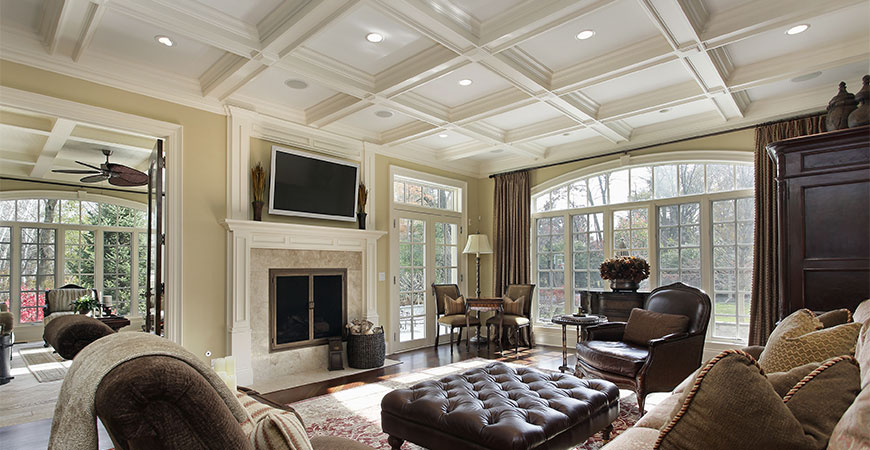
Implementing coffered ceilings in your home is one of the most effective ways of adding character to a space. Indeed, coffered ceilings are a unique home finish that creates a sense of dimension, depth and completeness in your space. However, there are a number of factors you should consider before moving ahead with your plans for this beautiful finish. The following are only six of these important considerations:
Get a Sense of the Elements That Comprise Coffered Ceilings
Uninformed homeowners tend to think that coffered ceilings simply consist of crown moldings placed strategically across their ceilings. But, coffered ceilings consist of many different elements that collectively create beautiful paneling on the ceiling. These composite parts include moldings, coffers, crossbeams, and paneling adhesive. Knowing what materials you need is the first step to creating a beautiful coffered ceiling in one of your central living spaces.
The Dimensions of Your Space
Knowing the dimensions of your space, in particular, the height of your space, is essential to selecting the correct dimension of coffers for your space. In general, you will want to select coffers with a depth that is proportionate to the height of your room. If your living space has especially high ceilings, you should opt for deeper coffers. Shorter ceilings will lend themselves to proportionately shorter coffers.
The Character of Your Home
Developing a clear sense of your home’s character is vital to both selecting and introducing the appropriate style of coffered ceiling. For example, does your home generally evoke a relaxed, cottage-inspired look? Do shades reminiscent of the beach pervade your home? If so, your coffered ceilings will want to reflect this broader design principle. As such, you may want to introduce slatted ceiling paneling between your ceiling’s coffers. This paneling is reminiscent of a cottage wharf and provides just the right counterpoint to your coffers’ strict sense of structure.
The Room You Are Working In
Traditionally, coffered ceilings have been found in a home’s central living spaces. This is largely because a home’s living room, family room and den tend to be larger than the other rooms in the house. But, smaller rooms in the home can also benefit from coffered ceilings. For example, more and more homeowners have begun to introduce coffered ceilings into their kitchens and sometimes even in their basements. A general rule of thumb to abide by when introducing coffered ceilings in unconventional spaces is to do so subtly. For example, your bathroom is not the most typical space in which to introduce coffered ceilings. As such, you will likely want to consider introducing simple and fairly shallow coffers in this space.
Lighting
One of the main aesthetic benefits of coffered ceilings is their ability to frame a room’s lighting fixtures. Before implementing coffered ceilings in your home, you will want to consider what sorts of lighting treatments you would like to see in the space. This is because the coffers themselves will largely revolve around your lighting scheme.
Perhaps, for instance, you are working in a living space which invites a large quantity of natural light. As such, you may want to simply introduce a lighting fixture in the center of your space. Alternatively, if you are working in the basement, you may want to introduce inset lighting all around the border of your space. On the whole, it is very important that you consider the lighting scheme in the room where you are introducing coffered ceilings. Once you have done so, you can research a contractor who can both help install your lighting features, as well as your beautiful coffered ceilings.
Be Original
Perhaps the most vital piece of design advice, when it comes to introducing coffered ceilings, is to be original. Coffered ceilings have long added a sense of luxury and completeness to European and American homes alike. But, this is not to say that your coffered ceilings need to mimic what has already been done.
Consider introducing coffered ceilings that are painted a different color than the ceilings themselves. However, be sure that the colors are complementary to one another. You can also think of creative layouts for your coffers. Traditional coffered ceilings abide by a rectangular paneling, but you may very well lay them out in a diagonal formation.
Coffered ceilings are a beautiful finish that work in a wide variety of different homes. But, before you commit to installing this finish, you want to thoroughly consider how you might do so in an aesthetically intriguing and creative manner. Make sure that your coffers are proportionate to the height of the space you are working in, too. In addition, it is important that you structure your coffers around your lighting rather than the other way around. Coffered ceilings are just one way that you can establish a creative and beautiful space that will prove inviting to all.
